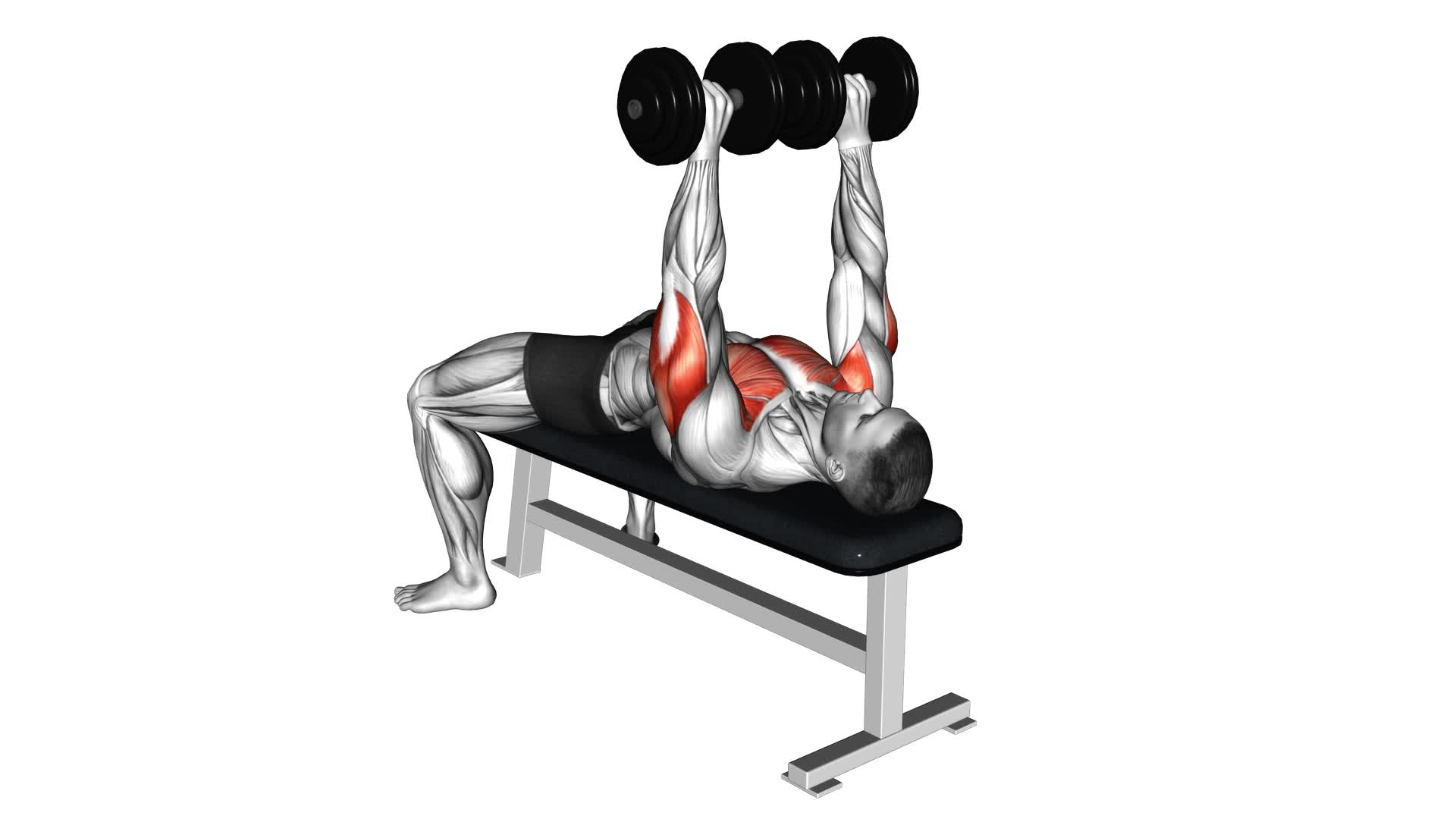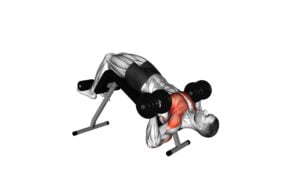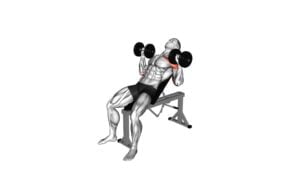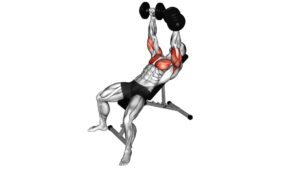Dumbbell Alternate Bench Press (High Start) – Video Exercise Guide & Tips

Looking to enhance your workout routine? Check out the Dumbbell Alternate Bench Press (High Start) – Video Exercise Guide & Tips!
Watch This Exercise Video
This exercise targets your chest, arms, and shoulders, providing a well-rounded upper body workout. In this guide, you'll find step-by-step instructions and helpful tips to ensure proper technique and form.
Don't miss out on variations and modifications to challenge yourself further. Avoid common mistakes and maximize your results with these expert suggestions.
Get ready to elevate your fitness game!
Key Takeaways
- The dumbbell alternate bench press targets the chest, arms, and shoulders, increasing strength and stability in these areas.
- Proper technique and form, such as maintaining a stable position on the bench and avoiding jerky motions, are crucial for effective and safe execution of the exercise.
- Variations and modifications of the dumbbell alternate bench press, such as using single-arm dumbbells or resistance bands, can provide additional challenges and benefits.
- Consistency in performing the exercise, following effective workout routines, and maintaining proper nutrition and hydration are key for maximizing results and achieving long-term success.
Benefits of the Dumbbell Alternate Bench Press
You'll experience increased strength and stability in your chest and arms when you incorporate the dumbbell alternate bench press into your workout routine. This exercise specifically targets your pectoralis major, deltoids, and triceps, resulting in enhanced muscle activation in these areas. The alternating nature of the exercise allows for better isolation of each arm, ensuring balanced development and reducing the risk of muscle imbalances or strength discrepancies between your left and right sides.
One of the key benefits of the dumbbell alternate bench press is the increased stability it provides. By using dumbbells instead of a barbell, you engage more stabilizer muscles in your shoulders, upper back, and core to maintain control throughout the movement. This not only strengthens these muscles but also improves your overall stability and balance.
Proper technique and form are crucial when performing the dumbbell alternate bench press to maximize its benefits and prevent injury. By maintaining a neutral spine, keeping your shoulders down and back, and controlling the weight throughout the entire range of motion, you'll ensure optimal muscle activation and reduce the risk of strain or discomfort.
With the understanding of the benefits and the importance of proper technique in mind, let's now dive into the specifics of performing the dumbbell alternate bench press correctly.
Proper Technique and Form
To maximize the benefits and prevent injury, it's important to maintain proper technique and form when performing the dumbbell alternate bench press. Here are some key points to keep in mind:
- Proper Grip: Hold the dumbbells with a neutral grip, palms facing inward. This grip helps target the chest muscles and reduces stress on the shoulders.
- Stable Position: Lie flat on a bench with your feet firmly planted on the ground. Keep your core engaged and shoulders pulled back to maintain stability throughout the exercise.
- Controlled Movement: Slowly lower one dumbbell towards the chest while keeping the other arm extended. Avoid any jerky or rapid movements, as this can strain the muscles and increase the risk of injury.
- Full Range of Motion: Lower the dumbbell until your upper arm is parallel to the ground, then press it back up to the starting position. This ensures that you're effectively targeting the pectoral muscles.
Common errors to avoid include using excessive weight, arching the back, and allowing the elbows to flare out. Remember to breathe consistently throughout the exercise to maintain proper form.
By mastering the proper technique and form of the dumbbell alternate bench press, you can effectively target your chest muscles while minimizing the risk of injury.
Now, let's explore some variations and modifications to add variety to your workout routine.
Variations and Modifications
For added variety to your workout routine, try incorporating variations and modifications of the dumbbell alternate bench press.
These variations and modifications can help challenge different muscles and keep your workouts exciting.
One advanced progression of the dumbbell alternate bench press is the single-arm dumbbell bench press. Instead of using both arms simultaneously, you'll only use one arm at a time. This variation helps improve stability and increases the demand on the working arm.
Another advanced progression is the incline dumbbell alternate bench press. By adjusting the bench to an incline position, you'll target your upper chest muscles more effectively. This variation can help develop a well-rounded chest and create a more aesthetic appearance.
When it comes to equipment variations, you can try using resistance bands instead of dumbbells. This variation adds an element of instability, forcing your muscles to work harder to stabilize the weights. You can also use a barbell instead of dumbbells for a different challenge and to engage more muscles in the movement.
Incorporating these advanced progressions and equipment variations into your workout routine can help you break through plateaus and continue making progress. Remember to always use proper form and start with lighter weights before progressing to heavier loads.
Common Mistakes to Avoid
To ensure proper form and maximize the effectiveness of your dumbbell alternate bench press, it's important to be aware of common mistakes and avoid them. Here are some common mistakes to watch out for and some exercise modifications to help you avoid them:
- Using too much weight: One of the most common mistakes people make is using weights that are too heavy. This can lead to poor form and increase the risk of injury. Start with lighter weights and gradually increase as your strength improves.
- Poor posture: Another mistake is having poor posture during the exercise. It's important to maintain a neutral spine and keep your shoulders back and down. Avoid rounding your back or hunching your shoulders forward.
- Lifting the weights too fast: Many people tend to rush through the exercise, sacrificing proper form for speed. Slow and controlled movements are key to target the muscles effectively. Take your time and focus on the contraction of your chest muscles.
- Neglecting the opposite arm: Since this exercise involves alternating arms, it's important to give equal attention to both sides. Neglecting one arm can lead to muscle imbalances. Make sure to alternate arms and give each side an equal number of reps.
By avoiding these common mistakes and making exercise modifications as needed, you can perform the dumbbell alternate bench press with proper form and maximize your results.
Now, let's move on to some tips for maximizing your results.
Tips for Maximizing Results
To maximize your results while performing the dumbbell alternate bench press, focus on proper technique and incorporate progressive overload into your training routine. Effective workout routines are essential for building strength and muscle. When performing the dumbbell alternate bench press, make sure to maintain proper form by keeping your back flat against the bench, your feet firmly planted on the ground, and your core engaged. This will ensure that you're targeting the muscles effectively and minimizing the risk of injury.
Additionally, gradually increase the weight you're lifting over time to challenge your muscles and promote growth. Progressive overload is key to stimulating muscle growth and strength gains.
In addition to effective workout routines, nutrition also plays a crucial role in maximizing results. To support muscle growth, make sure to consume enough protein in your diet. Protein provides the necessary building blocks for muscle repair and growth. Aim to include lean sources of protein such as chicken, fish, tofu, and legumes in your meals. It's also important to eat a balanced diet that includes a variety of fruits, vegetables, whole grains, and healthy fats. These nutrients provide the necessary energy and micronutrients for optimal performance and recovery.
Stay hydrated and consider incorporating supplements such as creatine and branched-chain amino acids to further enhance your results. Remember, consistency is key. Stick to your workout routine and maintain a healthy diet to maximize your gains.
Frequently Asked Questions
How Many Sets and Repetitions Should I Do for the Dumbbell Alternate Bench Press?
To progress in the dumbbell alternate bench press, it's important to determine the appropriate number of sets and repetitions for your fitness level and goals. The number of sets and repetitions can vary, but a common approach is to start with 3 sets of 8-12 repetitions.
As you become more comfortable and stronger, you can increase the number of sets or repetitions. Incorporating the dumbbell alternate bench press into your routine can provide benefits such as improved chest, shoulder, and tricep strength.
Can I Use the Dumbbell Alternate Bench Press as a Substitute for the Traditional Bench Press?
Yes, you can use the dumbbell alternate bench press as a substitute for the traditional bench press.
The dumbbell bench press offers several benefits for chest development, such as increased muscle activation and stability. Additionally, it targets each side of the chest separately, helping to improve muscle imbalances.
However, it's important to note that there are some differences between the two exercises, such as the range of motion and the involvement of stabilizer muscles.
Is It Necessary to Use a Spotter While Performing the Dumbbell Alternate Bench Press?
When performing the dumbbell alternate bench press, it's important to consider whether you need a spotter. While a spotter can provide assistance and ensure your safety, it isn't always necessary for this exercise.
The pros of using a spotter include added security and the ability to push yourself to the limit. However, the cons involve relying on someone else and potentially limiting your range of motion.
Ultimately, the decision to use a spotter should be based on your comfort level and experience.
Can I Perform the Dumbbell Alternate Bench Press With Heavier Weights for Muscle Building Purposes?
To maximize muscle growth and strength gains, incorporating heavier weights into your dumbbell alternate bench press routine is essential. By increasing the load, you create a greater stimulus for your muscles, leading to hypertrophy and increased strength.
However, it's crucial to maintain proper form and control throughout the exercise to minimize the risk of injury. Gradually progress to heavier weights as your strength improves and always listen to your body's limits to avoid overexertion.
Should I Incorporate the Dumbbell Alternate Bench Press Into My Upper Body Workout Routine or My Lower Body Workout Routine?
To determine whether to incorporate the dumbbell alternate bench press into your upper body or lower body workout routine, consider the muscle groups targeted.
The dumbbell alternate bench press primarily focuses on the chest, shoulders, and triceps. Therefore, it's most suitable for inclusion in your upper body workout routine.
However, if you're seeking to engage your lower body muscles more, it may be best to prioritize exercises that specifically target those areas in your lower body workout routine.
Conclusion
In conclusion, the dumbbell alternate bench press is a highly effective exercise for building upper body strength and muscle definition. By using proper technique and form, you can target multiple muscle groups and achieve optimal results.
It's important to avoid common mistakes and make necessary modifications to prevent injury. By following these tips, you can maximize your workout and achieve your fitness goals.

Author
Years ago, the spark of my life’s passion ignited in my mind the moment I stepped into the local gym for the first time. The inaugural bead of perspiration, the initial endeavor, the very first surge of endorphins, and a sense of pride that washed over me post-workout marked the beginning of my deep-seated interest in strength sports, fitness, and sports nutrition. This very curiosity blossomed rapidly into a profound fascination, propelling me to earn a Master’s degree in Physical Education from the Academy of Physical Education in Krakow, followed by a Sports Manager diploma from the Jagiellonian University. My journey of growth led me to gain more specialized qualifications, such as being a certified personal trainer with a focus on sports dietetics, a lifeguard, and an instructor for wellness and corrective gymnastics. Theoretical knowledge paired seamlessly with practical experience, reinforcing my belief that the transformation of individuals under my guidance was also a reflection of my personal growth. This belief holds true even today. Each day, I strive to push the boundaries and explore new realms. These realms gently elevate me to greater heights. The unique combination of passion for my field and the continuous quest for growth fuels my drive to break new ground.







